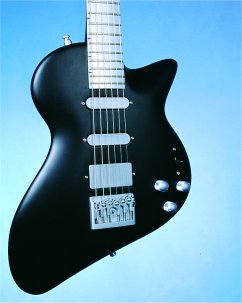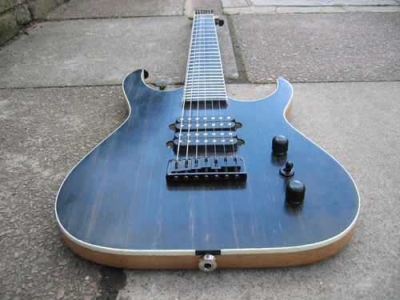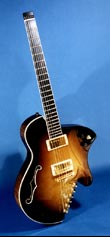A Gallery of Ergonomic Guitar Designs
In order to draw upon more ideas, I began to look for ergonomic guitars and found a number of interesting examples. These range from slight departures from the norm to completely different approaches.
Here is the Andreas Shark – a good example of a relatively conventional looking guitar that incorporates ergonomic elements. The most obvious is the extended bout that provides the right arm with excellent support. In addition, the offset bottom of the guitar likely has a similar effect to the shaping of the Klein in terms of aiding the positioning of the guitar while sitting. Unfortunately, this guitar is no longer in production.

Here is the Bardophone acoustic guitar, a far more radical design I came across last night. This is yet another design that makes use of the shaping of the lower bout to provide a better ergonomic experience. Note how it effortlessly places the neck at an angle. In addition, the design eliminates the need for a foot stool in order to raise the guitar to an appropriate height. This is significant because raising the foot results in twisting to the spine – not an ideal position.

This is an example of a design by Black Machine. The design’s primary nod to ergonomics is the use of a super thin body design. This has two effects. First, it lowers weight. Conventional bodies are around 1.75″ thick while the Black Machine guitars are a mere 1.1″ thick! Second, it brings the hands closer to the body reducing the outward extension of the arm from the shoulder joint. This places the shoulder in a more neutral position.

UPDATE 03.18.2006 The Kramer Delta Wing electric guitar is a fairly recent design. Its ergonomic features revolve around two particular elements – good support for the picking arm and its detachable leg rest. The leg rest is of particular interest because it has the potential for additional freedom in the aesthetics of the body while giving the designer a means of still providing good placement and positioning.

Here is Koll Guitar Company’s Custom RE 7/6 – a headless archtop. As noted on the Koll page, the guitar was influenced by the experiences of its customer who had played a Klein and loved the way the Klein’s neck angle and the way it sat on his leg. Notice the lower bout – it is essentially the shape of the Klein transplanted onto this design.

Another guitar that might qualify is the Parker Fly.
Super light, with a very thin wood body wrapped in some sort of synthetic skin. The back of the body is concave, which is nice when playing standing if you have anything other than a washboard flat stomach 😉
Playing seated the guitar balances perfectly on your right thigh – no hands and it still won’t fall off.
Also due I guess to the synthetics it never goes out of tune due to humidity or change in temperature. Nothing to do with ergonimics but a nice side effect of an intersting design.
My only complaint with the design is the knob placement. You can’t just reach over flick the pickup selector toggle; you really need to sort of come in from overhead and descend correctly or you will inadvertently twist a volume or tone knob. Visually pleasing layout, but not so pleasing in practice.
The synthetic skin on the Parkers is a carbon fiber composite. It is also used on the neck and would account for the guitar’s tuning stability.
I also noticed that the control layout is less than ideal on the Parkers. It seems much too crowded to be practical.
Check out burrellguitars.com for ergonomic acoustic guitars.
The Burrell guitars are definitely interesting examples of acoustic guitars designed with ergonomics in mind. I’ve focused primarily on electric guitars but I may reconsider given some of the interesting stuff out there in the acoustic arena. Thanks for the comment!
Hi there!
Love your site. You should include MORE of the ergonomic aspect on the neck design too. Novax fanned frets, and the Jerome Little Torzal necks, as well as Lace attempts a couple of year back. Although not ergonomic as such, people reports that they benefit from these necks and relieve pain from tendonitis, carpal tunnel and whatever.
There is an acoustic builder around too who makes acoustic guitars the opposite way an Ovation is made. With the bottom forming the way your belly is, but I forgot the luthiers name. They look like they would be designed by Picasso or Salvador Dali 😀
best regs
/Mats
Its NOT Burrell guitars as suggested above. They have curved and shaped TOP, while the back is fairly conventional, at least not concave. Burrells are great too BTW.
Thanks! I’m glad you’re enjoying the site. I appreciate the comments.
Actually, I’ve covered several of these. I covered a custom bass guitar with Torzal neck a while back. See Xavier Padilla’s Custom Electric Bass Guitar. More recently, I covered the Cybercaster and its twisted neck as well – The Lace Cybercaster Electric Guitar – A Guitar With A Twist.
I’ve also looked into the Novax fanned frets but have had a bit of difficulty in pinning down information with regards to their ergonomic benefits.
As far as the guitar you reference, I think I know who you mean but I’ll have to do some digging around. I’m working on a bunch of new stuff, btw. I’ve been in contact with several luthiers recently and I’ll be covering their various guitar designs in the upcoming weeks!
Hi again!
One thing that has always struck me when looking at ANY musician of any kind. Why is that tall people are more prone to play bass or large instruments? It fits THEM and are more ergonomic TO THEM perhaps? This is a neglected aspect in ergonomic guitar design too.
Say electric. I would’ve like the Klein to be shaped both in neck and body to fit tall people with large hands, as well with short people with small hands. The string LENGTH can’t be too much dabbled with but definitely the string WIDTH and string spacing. Tall people who tries out my Klein, think “only if it could be one scale/size larger overall”.
Short people like myself, thinks it fits ME perfectly. The only basses I can play comfortably are – thus – headless 34″ inch scale basses! But such things as Kleins ought to come in S, M, L, and XL!
I think, by and large, that if one should build ergonomic instruments especially electric guitars and basses, there are no such thing such as “one size fits all”. Human body stature must be measured, and each instrument will be very personal if there’s any truth to the ergonomic thing.
I’m with you – customization is the ideal although we have to balance that with the fact that not everyone can afford such a thing. Thus the goal becomes, like in any other area involving ergonomics, to fit it the largest populace possible. Of course, an instrument is far more personal and involved than, say a chair, but cost becomes an issue. I’d love to see big guitar manufacturers build them in various dimensions but that would prove cost prohibitive.
I’m really interested in the observations you make about the Klein. I’m on the taller side at 6’3″ and find my Klein based guitar build significantly more comfortable than any other guitar I’ve tried. Mine was based on the harp guitar which is a couple of inches wider than the standard Klein so this might be an idea for taller folks. That said, I could probably stand a bit less guitar under my picking arm. As a result, I’ve actually considered making my next guitar another Klein but based on the original’s dimensions. I’m still debating that however. Maybe I’ll put the idea to a poll something like “What should Rob build next?” One of the cool things about the new web site is the ability to run polls without resorting to some outside service.
My replica was built around the GAL available plan of the Klein Electric Harp guitar. When finished we found out that it was considearbly larger, and not fit to my bodys upper bout. It sort of gnawed into my ribs in a pecuilar way that felt uncomfortable. Not so with the original. We chopped of an inch or two and then the body was ok.
The Klein KX Bass replica I made, was molded around my tummy first! in order to get that curve.
My right hand – picking hand – rests on a considerable amount of wood, not jusst a sharp wedge, and the whole hand and arm has a sort of lever effect due to its resting place!
The only thing with headless and Kleins, is that the 12th fret seems to show up “early” when climbing the fretboard, on bass it’s even farther away. I’m interested in solving this problems, as well as the lever effect a neck on a Klein has. It’s too easy to make it move back and forth when changing chords position fast. It tilts a bit to easy out from the body, it’s too easy to give it a whack. A head can – actually – counterbalance this, without losing balance so it tips over. Maybe a Steinberger headpiece made of lead (!?!?) to make it heavier? 🙂
Has anyone of you, tried the Klein together with the DARE strap? or the “harness one”? Does it makes any difference?
Otherwise I agree with you Robert!
The larger GAL Klein harp body doesn’t have that effect on me fortunately. I could stand for it to be narrower though.
And, what do you think of the Klein bass guitar shape? It seems like a good shape to base a guitar on.
A strap might also be a way of addressing what you’re experiencing. Also, playing it in classical position really stabilizes the guitar and the Klein lends itself well to this.
Hi!
Having built 10 or so guitars over the years but not touched the stuff since my kids were born, I am finally reaching the stage where it’s time to dust off the old tools. It will be an ergonomic guitar for sure, an I am considering trying a twisted neck like the Lace Helix. Has anybody tried making one? I am wondering what it will do to trussrod function and how to get a fingerboard onto it… It might be easier to just stick with a solid maple neck like the old Fenders or perhaps stick a veneer onto it? Thoughts?
Other design choices are Lace Alumitones pickups (reduced weight) and a Steinberger type bridge. This South Korean company that sell their stuff on eBay (great service BTW!) are about to release their own version.
Once I get going, I will keep you posted.
Rgds,
Ola
I’m looking forward to seeing what you come up with Ola!
I have started my own blog to document my work here. Will be happy to receive comments.
Thanks,
Ola
Hi – Great site!
I first got interested in this site when attempting to make a guitar which was really minimal in demensions and weight which could be put in a standard size suit case to take with me on my travels.
It had to be a full scale length and be as quiet as possible for personal listening and a wide fingerboard for classical style playing.
I have had mixed results and more than 3 prototypes headless and conventional and find that the main problem is (as far as minimum length in concerned) is the tuning machines although a steinberger unit would minimise the length it would not allow for the string width distances apart as in the classical fretboard and I think the diamentions could be improved upon. I found a nice design that goes some way to what I’m seeking on the Portugees pages-a fan shaped head.
There are quite a few travel guitars out there ranging from the sublime to the rediculous one which takes my fancy is the Yamaha silent guitar which looks to my eyes a beautiful construction but fails in having a standard classical machine head making the instrument far longer than need be.
…Ahh well back to the drawing board!
p.s. more pictues please
Welcome to the site, Steve! It sounds like an interesting project. Let me know what you come up with.
BTW – have you looked at the approaches of some of the guitar designs on this site? There are others, but here’s one that relates to what you’re trying to accomplish – Henry Olsen ’s MaSh Acoustic Guitar.
Does anybody have any advice on selling a guitar design to a guitar manufacturer for production? Thank you.
I don’t have specific advice on it although I would point out that there isn’t much new under the sun when it comes to the big manufacturers. I doubt that the variations on a theme that are released regularly are done by anyone other than staff designers.
Looking around at the guitar builders covered here, you may want to consider working with a smaller builder. Smaller guitar makers are far more likely to try new and unusual designs. And if you’re design is off the beaten path, its more likely to see the light of day…
I am a 40 plus year player of jazz on archtops and have struggled all my life with trying to find some way to support a conventional archtop that will put the guitar neck in a good position. I feel that guitar makers ought to consider the support devices that are clamped on violins to allow the violin to be held between neck and shoulder. Such a device solves the position problem without compromising the beauty or the acoustics of the traditional violin. Such a support device could be designed for a conventional archtop but might prove too cumbersome. There is a device called a NeckUp. It helps but doesn’t completely solve the problem.
I feel sure that an ergonomic design is possible for a guitar, but what I am seeing so far are designs for which “ugly” is too polite a term.
The best solution I personally have come up with so far is a cushion that rests on my right leg. It is not ideal because to be stable, the guitar still needs support from the back of my chair (which is pretty wide), and to have the back of the guitar contact the back of the chair I have to rotate my body somewhat.
I am 73 and expect to depart this existence before this problem is solved!
Allen
From my point of view, “ugly” and aesthetics are a matter of perspective. Are jet fighters uglier than WWI biplanes? Are Formula 1 cars preferable to 50’s tail fins? What are you trying to accomplish? While a guitar isn’t as utilitarian as a vehicle, at the end of the day, it’s a tool for making music. So I suggest then that there is beauty in purpose. If the instrument accomplishes the goal of making music and makes it so the musician doesn’t have to sacrifice his health in the process, isn’t that “beautiful”? What good is it to play a 13lb Les Paul because of looks if it cripples your ability to play over the long term?
That said, this article dates back to the first few months of this site. Several years later and over 200 articles later, there are lots of other examples of instruments. Granted the majority of them are electric instruments. But I suspect 2009 will reveal some interesting designs more focused on the acoustic realm.
And thanks for joining the conversation!